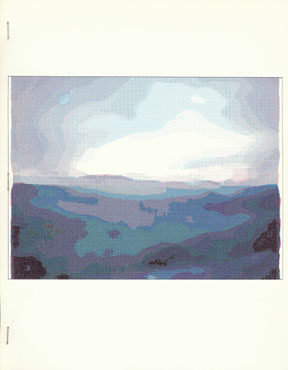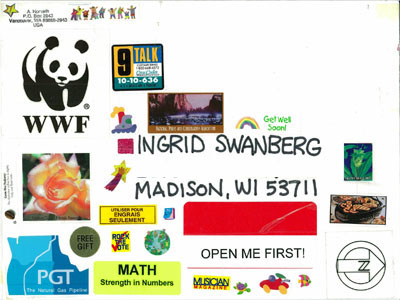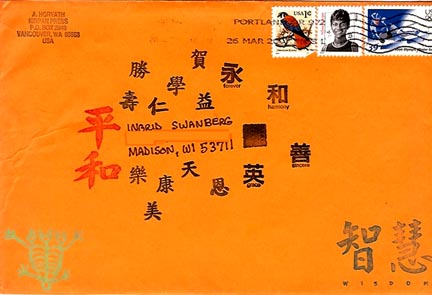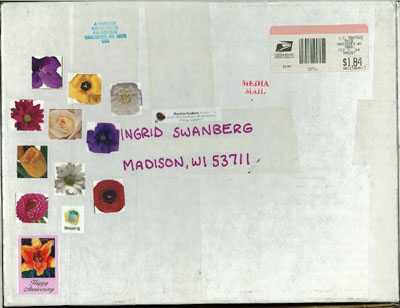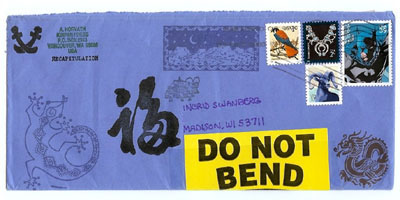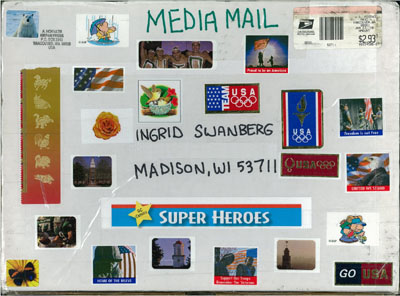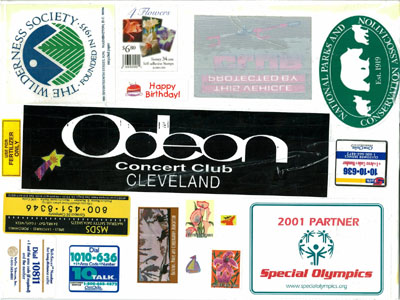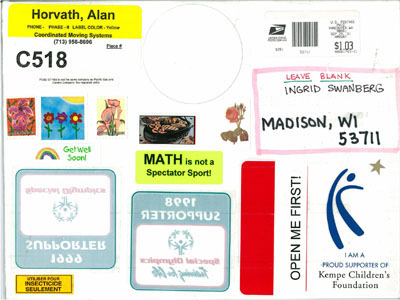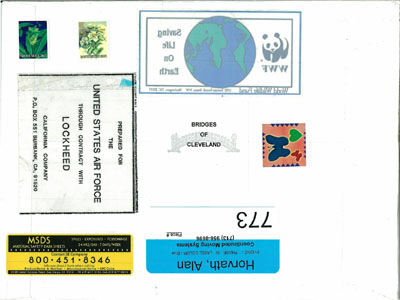|
"the fire / that burns the longest": remembering Alan Horvath
Alan Horvath, cover for (Scheduled) Random Sightings by d.a.levy (Kirpan Press)
I have a big cardboard file box filled with our correspondence, which began in early 1999 when Alan contacted the d.a.levy homepage I co-curate with Karl Young, asking for permission to reprint some of the levy paintings in my possession in a forthcoming Kirpan Press publication of levy's work. I had not yet connected with the larger group of people concerned with d.a.levy in Cleveland, and so did not know of Alan, who had been actively publishing poetry there from 1974 until he moved to San Francisco in 1981.
I tended to keep the envelopes. This was not only for the postmarks, as Alan did not usually date his letters, but also because they were creative and playful expressions in themselves. They often came hand-stamped with Chinese characters for such words as 'wisdom,' 'grace,' 'forever', with crossed kirpan daggers, and/or with Native American petro-glyphs from the Columbia River Gorge where Alan liked to go. They also came decorated (sometimes abundantly) with an array of different brightly-colored stickers: an Impressionist painting, a flower, a woman doing yoga, a description of "Peruvian Organic" coffee, "Cleveland Bridges" (the label for the floppy disc included with the Kirpan Press book Surfacing), a football player, American flags, butterflies, the unasked-for 'gift' sticker from the National Parks & Conservation Association soliciting contributions. . . These sticker collages-collations are somewhat in keeping with the Cleveland small press tradition of using everyday materials at hand
— from Burger King wrappers to city maps — to make art. The envelopes are done in a way that communicated Alan's having taken time and care and deliberation, qualities he brought to all of his work. It was the same with the boxes that yielded the wonderful Kirpan Press editions. Even the plain boxes were remarkable; so thoroughly were they sealed with clear tape that opening them was a challenge. Again, this was a communication—about valuable contents Alan and Kathy had poured hours into making, about what can happen in the mails, about how things are done right.
I printed a couple dozen handmade chapbooks/magazines/etc in cleveland, ohio in the mid-to-late 70s. in fact the mimeo I used was a gift from rjs & was the one used to print levy's ukanhavyrf**kinciti bak. besides reprinting some of levy's work, I printed two collections of rare levy which hadn't been distributed very much in the cleveland area: barking rabbit (t.l. kryss silkscreen cover) and red cat of reason (barking too).
middle:
after the 80s, I'm beginning to publish again. I am planning a series of four very small press chapbooks (65 copies/per) of rare levy material. some of the reprints will include "the box lunch travelog of freemont gulch," "5 cleveland prints," "the in group" play and a collection of poems which were printed in small press publications that were never reprinted in citi or any of the collections.
the end:
recently I've gained access to the internet at my work & was really surprised to see so many links for d.a. I think this is a good sign.
(January 19, 1999)
levy seems to be in fashion again. A lot of people are interested in reading someone else's interpretation of levy instead of f**king reading about what levy had to say for himself. that should be the starting point. ground zero. . . . one thing I know: after excavating all my contacts for missing levy pieces for 40 years, there will never be The Complete Collected Works of d.a.levy. . . . It is the missing pieces that tell me that my job is not finished . . .
(undated, Autumn 2007)
. . . these are not museum books, but meant to be seen by people who appreciate it. you price it too high, the wrong people read it. you make it too slick or too big & you send the wrong message. levy never made any money on his art/poetry. why should anyone else?
Alan's publication of the nine working mss drafts of levy's long poem Cleveland undercovers coincided with my writing at length about that poem in my dissertation (in which levy is a central figure). Perhaps because that particular Kirpan edition was so helpful to me, I have often wondered if that may have been a motivating factor in its timing. That certainly would have fit Alan's generous character. His support throughout the dissertation ordeal was unflagging. During that time he presented me with one of a Kirpan edition of two copies, (Specific) Random Sightings: All the News that Fits d.a.levy, a collection of newspaper clippings about levy from 1965 to 1999.
Once, during the writing of the dissertation, when I'd asked him for information about the Old Viaduct, which looms in Cleveland undercovers, he shared a story (in a letter I cannot now find) about playing touch football with some of his friends on that bridge one afternoon or evening. 'It was a miracle no one fell off,' I think he wrote.
He also sent me pages of printed-out listings of levy publications he had found being sold on online venues at exorbitant prices, including my own levy edition that was still in print and available from my press at the original price of $27.50, being offered online for as much as $100.
But if you really want to discover Alan's sense of humor, read his poems.
See dirty dishes" and "the secret" (Surfacing).
Alan's poetry is direct, spare, personal, ironic, often plain funny, at times stunning. He had the honesty and willingness to confront himself and the pain of life. He wrote in the spirit of the proactive, fearless Sikh soldier-saints whose kirpan daggers are worn as physical instruments of non-violence and defense of the vulnerable and disenfranchised. Symbolically, the kirpan means the power of truth to cut through lies.
Alan did not, in deference to levy's wishes, copyright the publications: ". . . I have never nor will ever file a copyright status claim to the library of congress for any of d.a.'s work" (February 21, 2001). However, he was impeccable about crediting people's work and had little patience for publishers who omitted attribution (in our first exchange he pointed out my mistaken statement, in Zen Concrete & Etc., that levy's "Last Dynasty Notes" were previously unpublished—actually, these visual poems were included in bill bissett's earlier blewointment press edition, Zen Concrete). Alan was also absolutely conscientious in handling copyrighted work. The annotated credits pages appearing at the end of the Kirpan editions are wonderfully detailed and complete, and many of them make for fascinating reading in their own right. Several of my Kirpan books are signed by the authors on the credits pages. A miniscule, handwritten number on the lower right corner of the credits page gives
which number of the edition one has in hand.
(November 21, 2005)
Alan published three volumes of Jim Lowell's correspondence with Kent Taylor and Tom Kryss, — letters about poetry, literature, books, politics, government corruption, baseball, football, readings, poets, writers, family, gardening, mutual friends, Ohio snow storms and heat waves. . . The facsimile pages of handwritten and typed letters are interspersed with art by Taylor and Kryss, photos of all of them, a portrait of Jim by Hilary Krzywkowski, and a moving photo of Jim's empty chair at his desk after he passed by Cindy Marx. . . In this correspondence we are able to gain a glimpse of the deep camaraderie of the Cleveland 'brotherhood' of poets and artists (one which by no means excludes sisters) that first gathered in the 60s around levy and Lowell and continues. Alan found Lowell's lifelong dedication to literature an inspiration.
even as he was dying,
Alan was as thoroughgoing an editor as I have ever known, from his encouragement of writers to his meticulous care in the presentation of their work. When it came to reprinting problematic levy material, we both tended to prefer to err on the side of inclusion. I consulted Alan when I was about to present a previously unpublished levy poem in a forthcoming issue of Abraxas. The mss I was working from had a number of hand-written indications of lines to be cut (who had indicated the cuts was unclear). He advised me to leave the lines in, and to simply indicate with brackets where the markings occurred. This was typical of his open approach as a textual editor, sharing all the information possible while upholding the highest standards of presentation.
The physical book itself was of central importance to Alan, in the sense of the pleasure taken in the paper, printing, and compilation, but also in the sense of a recognition of production limitations. His books were hand-assembled once enough pages had been printed and when the time was right, and thus there were natural constraints governing a book's editing and design that offered a positive organizing principle now largely lost in the economies of internet publishing.
Alan wrote in a letter of October 21, 2001:
Office Copy, a collection of poems about Alan's years of work for a large corporation, is also printed on grey stock throughout the poetic text, but it is a softer, textured grey of company fog, subterfuge, tedium.
those of you
now that I'm dead
don't think about
every minute
but after this moment
I think that, for Alan, part of letting the poet 'speak for himself,' was a feeling that a poem
occupies its own moment, stands by itself, and speaks itself. I think this is the reason Alan printed
the anthology The Clevelanders, Vol. III, which included work from eighteen contributors,
without the authors' names appearing anywhere in the body of the text, but only on the final
credits pages (except where a name was included as part of original art). He did something similar
in Surfacing, co-authored with his friend Dave Pishnery, listing the poems by both authors
in the table of contents, and then presenting them in the body of the book without designation, in
an order seemingly suggested by the poems themselves. This approach helps one to appreciate the
work solely on its own merits. Just read the poem, undistracted by who wrote it and by your
preconceptions about them.
Alan elicited a variety of original individual works for his editions. Some examples are: the original individual cover collages by Richard Werner on the edition of Lowell correspondence to Taylor and Kryss (Sleeping Nude on Top of the Sheets); the silk screen covers by Mike Schaefer (A Series of Sharp Points), Dave Pishnery (Surfacing), and Tom Kryss (Looking for d.a.levy [Random Sightings: The d.a.levy Bibliography, Volume 2] and the Lowell correspondence to Tom, Notes to Cleveland). Kryss also did individual covers for Grace Butcher's book Horses in the Snow (a combined Kirpan Press/Black Rabbit Press edition), using ink and watercolor on a stamped imprint; some rare copies present the artwork on a tipped-in paper inset.
In the recent broadside card series, "Stories from The Flats" (a collaborative Kirpan Press effort with Tom Kryss's Black Rabbit Press), there is a decided focus on these touches of original handwork and art.
The broadsides were done in editions of 75-100 copies. Unique outer envelopes were designed for each illustrated card, some produced on inkjet printers, others illustrated individually, by hand. The envelopes for my broadside, "the pure," have each been pressed with a red lipstick kiss, thematically relating to the final line of my poem (thank you, Kathy!).
Tom Kryss did original artwork on the covers and envelopes of some 20 of The Flats series, working with ink and painted or sponged watercolor on stampings. Many of these have the artwork on paper insets tipped in. One, Michael Basinki's "Ghosts Live in Closed Eyes," has a watercolor-stamped paper inset tipped in on the cover, and the envelope has ink-stamped botanical prints on canvas that has also been tipped in.
A number of The Flats series envelopes appear with the familiar signatory stampings of Chinese characters, Columbia River Gorge petro-glyphs, and crossed kirpans.
The broadsides come to readers with their envelopes sealed. One has to break the seal. One's attention is brought to this moment of opening, this moment of the poem, from which there is no going back.
Return to Index for Alan Horvath Memorial
|
